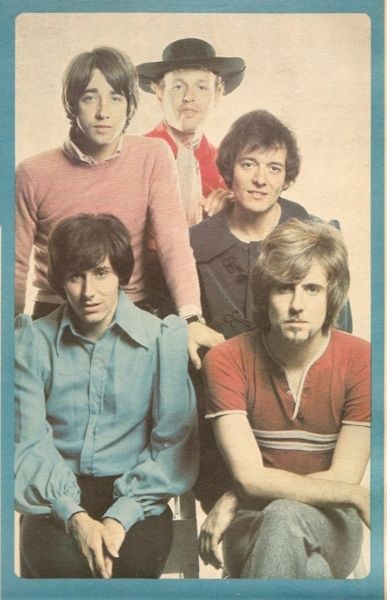When discussing timeless classics from the 1970s, “Long Cool Woman in a Black Dress” by The Hollies inevitably takes center stage. As a defining track from their Distant Light album, released in 1971, this song showcases the band’s versatility, moving beyond their pop-rock origins into a grittier, Americana-inspired sound. This particular piece of music remains a shining example of how The Hollies could innovate and adapt their style while staying true to their melodic roots.
Distant Light marked a significant moment in The Hollies’ discography. It was their eleventh studio album, blending elements of rock, folk, and pop in a way that appealed to a diverse audience. Released during a time when bands like The Rolling Stones and Creedence Clearwater Revival dominated the charts, The Hollies used Distant Light as a platform to experiment with a sound that leaned more heavily into American rock influences. The album was also the last to feature lead vocalist Allan Clarke before his brief departure, making it an emotional milestone for long-time fans.
The track “Long Cool Woman in a Black Dress” stands out as the album’s most iconic. Notably, it reached No. 2 on the Billboard Hot 100 in the United States and became a defining hit for the band. Its popularity is a testament to the track’s ability to blend compelling storytelling with an unforgettable groove.
One of the most remarkable aspects of “Long Cool Woman in a Black Dress” is its stripped-down yet impactful instrumentation. The song eschews the typical multi-layered harmonies The Hollies were known for, instead placing its focus squarely on the lead guitar riff and Allan Clarke’s smoky, blues-infused vocals.
The electric guitar is the star of this piece of music. The opening riff immediately captures the listener’s attention with a swamp-rock energy reminiscent of Creedence Clearwater Revival’s style. Its driving rhythm creates a sense of urgency reflecting the song’s narrative of a high-stakes, noir-inspired encounter. Throughout, the guitar work remains sharp and purposeful, combining rhythm and lead guitars to deliver a dynamic soundscape that is both gritty and melodic – a masterful display that sets the track’s retro-rock appeal.
The bass guitar and drums form a tight, driving rhythm section anchoring the song. The drumming is simple but effective, with a steady beat complementing the track’s rockabilly undercurrents. The bass line grooves effortlessly alongside the rhythm guitar, creating a syncopated feel that makes the song irresistibly danceable.
Allan Clarke’s vocal performance is another standout element. Unlike many Hollies songs featuring lush vocal harmonies, this track spotlights Clarke’s raw, solo delivery. His raspy tone and controlled intensity lend the song an edge that perfectly matches the mysterious and rebellious mood of the lyrics. This departure from the norm paid off by adding grit and authenticity.
Interestingly, this track features no significant piano presence. While The Hollies often incorporated piano into earlier tracks for melodic depth, the deliberate absence here reinforces the song’s minimalist, rock-driven aesthetic, ensuring the guitar remains the focal point, emphasizing the raw energy defining the track.
The story told through sound and lyrics is cinematic, recounting a secret agent’s encounter with a femme fatale during a Prohibition-era nightclub raid. The lyrics read like a crime thriller, with vivid imagery and high-stakes action. Lines such as “She was a long cool woman in a black dress / Just a 5’9” beautiful tall” paint a mysterious, alluring figure. The combination of storytelling and atmospheric instrumentation gives the track a film-noir quality that captivates listeners even decades later.
This song thrives on its simplicity — straightforward chord progressions and infectious rhythm avoid over-complication, instead creating an atmosphere that feels both nostalgic and immediate.
The enduring appeal of “Long Cool Woman in a Black Dress” lies in its unique blend of rock, storytelling, and mood. It exemplifies a rare success for a British band crafting a distinctly American sound. Its swamp-rock aesthetic and high-energy execution give it a timeless quality, resonating with classic rock enthusiasts and casual listeners alike.
Moreover, the song’s influence echoes in many modern tracks rooted in rockabilly and Americana traditions. Its no-frills production and instrumentation continue inspiring musicians seeking accessible yet impactful music.
For those who enjoy this track, consider these recommendations capturing similar vibes:
- “Green River” by Creedence Clearwater Revival — swamp-rock vibe with infectious groove and gritty guitar riffs.
- “Tumbling Dice” by The Rolling Stones — bluesy undertones and storytelling swagger.
- “Bad Moon Rising” by Creedence Clearwater Revival — upbeat tempo with vivid imagery.
- “American Woman” by The Guess Who — rebellious spirit and guitar-driven sound.
- “The Joker” by Steve Miller Band — mellow option with clever lyrics and catchy melody.
Allan Clarke’s gripping vocals, the captivating guitar-driven arrangement, and the cinematic storytelling make “Long Cool Woman in a Black Dress” a quintessential classic that continues to hold audiences spellbound. Whether a lifelong fan or newcomer to classic rock, this track is a must-listen, offering a compelling portal into the rich world of 1970s rock.
As Allan Clarke once said while reflecting on the track: “This song was different for us — it had grit and an edge that pushed our sound into new territory. It captured a mood and story that still resonates today.” This testimony from the band’s lead vocalist underscores the lasting power and significance of this iconic piece.
